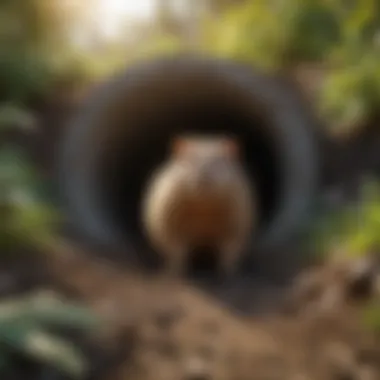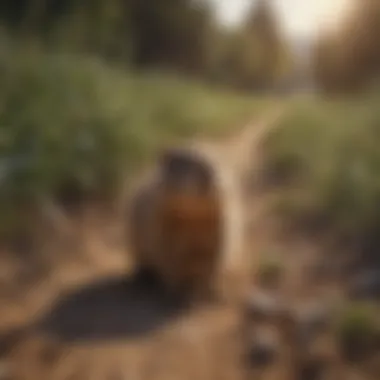Effective Strategies for Gopher Control and Prevention


Intro
Gopher control is a significant concern for many homeowners. These small rodents, known for their burrowing behaviors, can cause extensive damage to lawns, gardens, and agricultural areas. Understanding their biology and habits is crucial for effective management. This article presents a comprehensive approach to gopher control, emphasizing strategies that are both practical and sustainable. Through understanding pest identification, prevention methods, and do-it-yourself solutions, homeowners can gain the knowledge needed to combat gopher issues effectively.
Pest Identification
Identifying the presence of gophers and their activities is the first step in effective control.
Common Household Pests
Gophers (family Geomyidae) are often confused with other pests such as moles and voles. They are characterized by their strong forelimbs suited for digging and a small, stocky body. Their fur is typically brown or gray, helping them blend into their environment.
Signs of Infestation
To determine if gophers have invaded your property, look for these indicators:
- Mounds of soil: Gopher activity typically leaves behind distinctive mounds of soil, often crescent-shaped. These mounds are a result of their digging and can appear in clusters.
- Damaged plants: If you find uprooted plants or eaten roots, gophers may be responsible. The plants often wilt or die, signaling that their root systems are compromised.
- Tunneled areas: Gophers create extensive tunnel systems beneath the surface, which can lead to soft spots in your lawn or garden.
It's essential to differentiate gophers from similar pests to apply the correct control measures.
Prevention Methods
Preventing gopher infestations is often more effective than attempting to eliminate them after they have settled in. Here are some essential strategies.
Environmental Modifications
Making adjustments to your landscape can minimize gopher attraction:
- Proper irrigation: Gophers are attracted to wet areas. Ensure your garden does not retain unnecessary moisture, as this can draw them in.
- Garden barriers: Installing physical barriers like wire mesh around gardens can help deter gophers from accessing your plants.
Home Maintenance Tips
Regular home maintenance can also discourage gophers:
- Monitor your lawn: Regularly check for signs of infestation and address any indicators early.
- Remove food sources: Store garden supplies like bulbs and tubers in sealed containers to reduce food availability.
DIY Pest Control Solutions
For those looking to manage gopher populations themselves, several effective DIY strategies exist.
Natural Remedies
Some homeowners prefer non-toxic methods to deter gophers. These include:
- Castor oil: Mixing castor oil with water and applying it to the affected areas can repel gophers due to its unpleasant odor.
- Plants with strong scents: Grow plants like marigolds or garlic around gardens to create natural barriers.
DIY Traps and Barriers
Using traps can effectively reduce gopher numbers:
- Types of traps: There are several types of gopher traps available, including scissor traps and harpoon traps, which are designed to kill or capture gophers efficiently.
- Placement of traps: Place traps within active tunnels to increase efficacy. Always check traps regularly to ensure prompt removal of captured pests.
"Effective gopher control often requires a combination of techniques, including prevention and direct management."
Understanding Gophers
Understanding gophers is critical for effective control strategies. These rodents can cause significant damage to gardens, lawns, and agricultural land. Having knowledge of their biology, habitat preferences, and behavior creates a foundation for developing methods to manage their populations efficiently. Homeowners should appreciate the urgency of addressing gopher infestations, as they can lead to costly repairs and disruptions in landscape aesthetics. This section will delve into the key elements surrounding gophers, allowing readers to grasp the necessary considerations for effective control.
Biology of Gophers
Gophers belong to the family Geomyidae. They are small, burrowing rodents with distinct physical traits. Gophers typically have short limbs, robust bodies, and cheek pouches for transporting food. They range from about 5 to 14 inches in length and can weigh up to a pound. Their fur colors vary, but it tends to be brown or gray, providing them with camouflage against predators and their environment. Gopher offspring are born blind and hairless, requiring parental care for several weeks post-birth. Understanding their reproductive cycle can help determine the best times for control efforts, as populations can multiply rapidly under favorable conditions.
Habitat Preferences
Gophers prefer loose, well-aerated soils, which facilitate easy tunneling. They commonly inhabit grasslands, agricultural fields, and gardens. These rodents create extensive tunnel systems underground, which they use for foraging and nesting. The depth and complexity of these tunnels can vary significantly based on soil type and vegetation. Gophers do not typically dig in rocky or clay-heavy soils. This preference emphasizes the importance of soil management in gopher control efforts.
It's important to assess local soil conditions and landscape characteristics when preparing a pest management plan. Gardens and lawns that provide the right balance of moisture and temperature tend to attract gophers more readily than dry or compacted areas.


Gopher Behavior
Gopher behavior is predominantly solitary, and these rodents are known to be territorial. They construct a network of tunnels to search for food such as roots, bulbs, and various plants. Their feeding activity results in distinctive mounds of dirt called gopher mounds, which are visible on the surface. Gophers are primarily active during the early morning and late afternoon, making these times more effective for observation or trapping efforts.
Tip: Understanding when gophers are most active can significantly enhance control strategies. Timely intervention during peak activity hours yields better results.
Besides foraging, gophers also engage in digging as a means of creating new tunnels or expanding existing ones. This habitual behavior can lead to increased infestations in a short time. Therefore, recognizing this behavior is essential for homeowners seeking to control gopher populations effectively.
Identifying Gopher Infestations
Recognizing a gopher infestation early is crucial for effective management and control. By identifying the signs that indicate gopher activities, homeowners can intervene before damage escalates. Infestations can lead to unhealthy lawns and gardens, impacting not just aesthetics but also plant health. Knowledge about how to spot gopher signs allows for timely action, which can save both time and resources in the long run.
Signs of Infestation
Identifying the signs of gopher infestation is the first step in addressing the problem. Here are some common indicators:
- Mounds of Soil: This is perhaps the most visible sign. Gophers create fan-shaped mounds of soil, often measuring 12 inches across and rising about 4 to 6 inches high. The soil appears loose and freshly turned.
- Tunnels: Gophers dig extensive tunnel systems underground. If the ground feels soft or spongy, or if you observe sunken spots in your yard, these can be signs of gopher activity.
- Damaged Plants: Gophers often feed on plant roots. If you notice sudden wilting or if plants seem to be uprooted without cause, gophers may be responsible.
- Visible Activity: Sometimes, you can actually see gophers above ground, especially around their burrow entrances. This may be rare but indicates a significant presence.
Regularly inspecting your garden for these tell-tale signs can help you catch an infestation early, allowing for appropriate actions to be taken without the need for drastic measures later on.
Distinguishing Gophers from Other Pests
When dealing with a suspected pest issue, it is essential to correctly identify the type of animal involved. Gophers can be mistaken for other burrowing animals, such as moles or voles. Here are some key differences to help with identification:
- Gophers: They have large front incisor teeth used for digging and can be identified by their robust bodies. Gophers are usually around 6 to 12 inches long.
- Moles: Unlike gophers, moles primarily consume insects and earthworms. Their mounds tend to be more conical and do not have lateral tunnels like gopher burrows.
- Voles: These small rodents are similar in size to gophers but have different behaviors and feeding habits. Voles tend to leave behind gnaw marks on grass or plants rather than uprooting them.
Knowing the specific characteristics of gophers versus other pests allows for more tailored control strategies, ensuring that homeowners target the right problem.
It's advisable to consult local pest management resources or agricultural extensions when uncertain about the type of pest present. Being precise in identification can prevent unnecessary treatments and save time and money.
Preventive Measures for Gopher Control
Gopher control encompasses both direct and indirect methods of managing these pests. Preventive measures are particularly crucial as they can reduce the likelihood of infestations before they even start. Implementing effective preventive strategies can save homeowners from costly damages, and keep their gardens and lawns healthy and beautiful. In the following subsections, the emphasis will be on practical approaches to maintaining landscapes that discourage gopher presence.
Healthy Lawn Management
A well-maintained lawn is less likely to attract gophers. These critters search for environments that provide plenty of food resources—such as roots of grasses and plants. To deter them, homeowners should focus on creating a robust lawn. Regularly mowing grass to the appropriate height can help. It is also essential to aerate the soil. This process promotes root growth and can make the lawn less appealing to gophers.
Additionally, using quality fertilizers fosters strong root systems. Healthy roots can withstand some level of tunneling activity. Watering practices also play a significant role. Overwatering can lead to saturated soil which may attract gophers, while drought conditions can make plants more vulnerable to gopher attacks. Striving for a balanced watering schedule is key.
Landscaping Choices
Selecting the right plants for landscaping can influence the likelihood of gopher activity. Some plants are less attractive to these rodents and can serve as a buffer. For instance, deep-rooted native plants can deter gophers from burrowing nearby, as they have a harder time feeding on them.
It may be helpful to create barriers of gopher-resistant plants. Species such as lavender or various types of sage can act as natural deterrents due to their aromatic oils. When designing a garden, spacing plants adequately can help, as overcrowded areas can provide hiding spots for gophers.
In addition, it is important to avoid planting highly attractive vegetation close to garden beds. Instead, homeowners might place more desirable plants further away or use raised beds with barriers installed underground to limit access.
Exclusion Techniques
Another layer of prevention involves exclusion techniques which physically prevent gophers from accessing certain areas. In vegetable gardens or delicate flower beds, hardware cloth or gopher wire can be buried around the perimeter. The wire should be extended about one foot below the surface and at least two feet above; this prevents gophers from burrowing underneath.
When excavating areas or planting new trees, consider using gopher baskets. These wire mesh containers protect the roots of young trees and shrubs, allowing them to establish before being exposed to gopher tunneling. Homeowners must also regularly inspect their property for signs of burrowing and plug any holes as they are noticed.
"Prevention is the most effective strategy in gopher management. Taking proactive steps can minimize disruption and damage to your property."
By focusing on these preventive measures, homeowners can substantially decrease the risks associated with gopher infestations. Each of these strategies offers a protective layer that, when combined, can lead to an environment that is less inviting to gophers.
Direct Control Methods
The Direct Control Methods section provides crucial insights into immediate and tactical approaches for managing gopher populations. Homeowners often seek quick solutions when faced with gopher infestations, as these pests can cause significant damage to gardens, lawns, and landscaping. Understanding various direct control methods is vital, as it allows homeowners to choose the most effective strategies tailored to their specific situations. The focus here is on trapping, poison baits, and the introduction of natural predators. Each method comes with its own merits, requirements, and cognitive considerations.
Trapping Strategies
Trapping is one of the most effective direct control measures against gophers. It is a method that not only provides quick results but is also environmentally safer than chemical alternatives. There are several trap designs available, including single and double catch traps.
When using traps, it is important to identify the most active gopher tunnels. Placing traps in these areas will significantly increase the likelihood of a successful catch.


Here are some key aspects to consider:
- Placement: Locate fresh mound openings, as this indicates active tunneling.
- Baiting: Some traps do not require bait, but including natural bait such as carrots or peanut butter can enhance attraction.
- Monitoring: Check traps regularly to ensure humane treatment and avoid prolonged captivity for the captured gopher.
"Trapping gophers allows for immediate control while minimizing the impact on surrounding wildlife."
By employing trapping strategies, homeowners can effectively manage gopher problems while being mindful of other animals in the ecosystem.
Poison Baits
Poison baits represent another direct control method, although they must be used with caution. These baits contain chemicals designed to eliminate gophers effectively. However, improper use can pose risks to pets, wildlife, and even humans. Understanding the products available is essential for safe implementation.
- Choosing the Right Bait: It is crucial to select a poison that targets gophers specifically. Many products contain anticoagulants that require the gopher to consume multiple doses for effectiveness.
- Placement: Baits should be placed in active burrows. This ensures that the gophers will consume the poison without affecting non-target species.
- Follow Instructions: Always adhere to the label instructions to ensure safety and effectiveness.
While poison baits can be effective in reducing gopher populations, homeowners are encouraged to combine this method with other strategies for a more comprehensive approach to pest management.
Natural Predators
Introducing natural predators is a method that integrates ecological balance into gopher control strategies. Animals such as owls, hawks, and snakes can play a significant role in keeping gopher populations in check. Encouraging these predators to inhabit your area can serve as a long-term solution.
Here are some practical steps to consider:
- Habitat Enhancement: Create an environment that attracts these natural predators by providing shelters and perches.
- Conservation: Avoid using chemicals that may harm these beneficial animals. This ensures their presence remains stable in the ecosystem.
- Monitoring: Observe shifts in gopher populations, as a natural predator may decrease the need for more aggressive control methods.
Natural predation is a sustainable approach, aligning with integrated pest management principles. By fostering a balanced ecosystem, not only are gophers controlled, but overall biodiversity is supported.
Environmental Considerations
Managing gopher populations is not only a matter of protecting gardens and lawns; it also intersects with broader environmental factors. Understanding Environmental Considerations helps homeowners recognize the consequences of their pest control strategies. It is essential to balance effective gopher control with ecological integrity. As we explore this interplay, we become more mindful of the potential impact our methods have on local ecosystems.
Impact of Pest Control Methods
The choice of pest control methods can significantly influence the environment. Certain techniques, such as poisons, can lead to secondary poisoning of non-target species, including pets and wildlife. For instance, using products that are detrimental may result in a decline in the population of natural predators of gophers, disrupting the local food chain. Therefore, when selecting pest control options, it is crucial to assess their ecological footprint.
Factors to consider include:
- Chemical Composition: Understand what ingredients are in your chosen products. Some substances can cause long-term soil and water contamination.
- Application Methods: How you apply control measures can affect nearby flora and fauna. For example, over-spraying can harm beneficial insects and plants.
- Timing: The timing of control measures is also significant. Applying methods in the wrong season can disrupt breeding cycles and lead to wider ecological repercussions.
"The aim is to mitigate harm while effectively managing gopher populations."
In light of these factors, it becomes clear that choosing sustainable methods can yield better outcomes. Integrated pest management, which combines biological, cultural, and mechanical practices, serves as a more environmentally-conscious approach.
Sustainable Practices in Gopher Management
Sustainability in gopher control implies using techniques that have a minimal impact on the ecosystem while effectively managing pest populations. A few practices can enhance sustainability in managing gophers:
- Cultural Practices: This includes modifying planting techniques or schedules to create less favorable conditions for gophers. For example, using deeper root systems and choosing plants that are naturally resistant to gopher damage can deter their activity.
- Physical Barriers: Installing barriers can prevent gophers from accessing important areas like gardens. These barriers can be wire mesh or underground fencing, which reduces the need for chemical controls.
- Natural Predators: Encouraging the presence of natural predators like owls or hawks can assist in controlling gopher populations. Building nesting boxes or habitat improvements can attract these helpful animals, creating a more balanced ecosystem.
- Composting Practices: Composting reduces the amount of organic waste that may attract gophers. Proper management of compost can minimize the likelihood of gophers seeking out food sources around gardens.
By incorporating these sustainable practices, homeowners can achieve effective gopher management while nurturing the environment. This integrated approach not only targets the pest but also promotes a healthier ecosystem.
DIY vs. Professional Help
Addressing gopher infestations presents a critical decision for homeowners: whether to take a do-it-yourself (DIY) approach or to hire a professional pest control service. Each option carries distinct benefits and considerations that can significantly impact the effectiveness of control measures and the overall management strategy.
Choosing to handle gopher control independently can be appealing due to potential cost savings and a sense of empowerment. Homeowners often appreciate the flexibility of customizing their approach to suit their specific property conditions. With tools readily available and a variety of online resources, many find that they can conduct their own inspections, set traps, or utilize natural deterrents with moderate success. However, it is crucial to weigh these advantages against the time commitment and physical effort required. DIY methods may yield limited results if not executed correctly. Moreover, insufficient knowledge about gopher behavior and habits can lead to prolonged infestations.
Conducting thorough research and following best practices is vital when choosing to DIY. Inadequate strategies may exacerbate the problem.
Should homeowners opt for professional assistance, they unlock access to expert knowledge and advanced techniques. Pest control professionals typically employ a combination of methods honed through experience and a thorough understanding of gopher biology. They can evaluate the situation comprehensively and tailor a strategy that aligns with the unique conditions of the property. The potential for a quicker resolution to the infestation issue can be a significant advantage of professional help. However, it is important to consider the financial implications, as hiring a pest control service requires an investment that may vary by provider.
Ultimately, the decision lies in assessing both the severity of the infestation and one’s own readiness to manage the situation. Understanding when to take action personally or seek professional guidance is vital in achieving effective gopher control.
When to DIY
Engaging in DIY gopher control can be sufficient depending on the infestation size and frequency of signs like mounds or uprooted plants. Here are some instances where it could be feasible to go the DIY route:
- Mild Infestation: If the infestation appears limited, simple measures like trapping or using repellents might be effective.
- Budget Constraints: When financial considerations are a priority, DIY solutions can provide a lower-cost alternative.
- Preference for Natural Solutions: Some homeowners prefer non-toxic methods to control pests, making DIY more appealing.


However, it is essential to evaluate the skills and resources available. Research can reveal numerous effective strategies, but accuracy and diligence are necessary to ensure success. In some cases, if attempts prove ineffective, escalating to professional help might be the pragmatic choice.
Selecting a Pest Control Professional
Choosing a pest control professional requires careful consideration to ensure that the gopher control measures employed are effective and environmentally sound. Here are some crucial factors to think about when selecting a service:
- Credentials and Experience: Look for licensed professionals with experience in gopher management. Their knowledge can significantly enhance successful outcomes.
- Methods Employed: Understanding the techniques a company uses is important. Some may prefer chemical solutions, while others focus on more sustainable methods. Choose one that aligns with your values and needs.
- Reputation: Research customer reviews and ask for references. Positive feedback from previous clients can indicate a reliable service provider.
- Cost Estimates: Request quotes from multiple providers. It is vital to evaluate whether the cost aligns with the services offered and if it fits within one’s budget.
Taking the time to choose the right professional can lead to more effective management of gopher populations, ensuring both immediate relief and long-term solutions.
Employing a strategic approach to gopher control—whether through DIY methods or engaging professionals—enables homeowners to make informed choices, ultimately leading to more significant successes against these persistent pests.
Monitoring and Maintenance
Moreover, maintaining the landscape can naturally deter gophers. By understanding their habits and behaviors, effective monitoring can be achieved. Identifying problematic areas in your garden or lawn can guide you in crafting a more targeted approach to managing gopher presence.
Regular Inspection Techniques
Regular inspections are key to successful gopher control. Observing for fresh signs of gopher activity should be a daily practice. Digging new tunnels, fresh mounds of soil, or signs of plant damage are indicators that gophers are active in the area.
Some effective techniques for inspections include:
- Visual checks: Walk through your garden or lawn regularly to look for new mounds or burrow entrances.
- Soil examination: Gently probe the soil in potential gopher activity areas to check for fresh soil or displaced plants.
- Time of day: Mornings can be ideal for checks, as gophers may be closer to the surface early in the day.
Maintaining these inspection practices can lead to early detection and easier management of gopher populations.
Ongoing Prevention Strategies
Once a gopher control strategy is established, ongoing prevention strategies must be implemented to keep them at bay. Implementing preventative measures not only reduces the risk of future infestations but can also improve the overall health of your landscape.
Some effective ongoing prevention strategies include:
- Regular landscape audits: Keep an eye on your plants and soil. Healthy plants are less desirable to gophers.
- Using repellents: Certain products can deter gophers. Natural repellents can be quite effective in protecting sensitive areas.
- Employing barriers: Fencing or underground barriers can limit gopher access to your garden or flower beds.
- Engaging in community efforts: Remember that neighbors can also impact gopher populations. Collaborative efforts to monitor and manage gopher activity can be beneficial.
By executing these strategies consistently, the chances of successfully deterring gopher infestations increase. This emphasis on continuous attention and action forms a solid foundation for long-term management.
Legal and Ethical Considerations
Understanding the legal and ethical implications of gopher control is crucial for homeowners and pest managers. It is essential to comply with regulations and consider ethical practices while managing gopher populations. Non-compliance with the law can lead to fines or legal consequences, while unethical practices can harm local ecosystems and violate moral standards.
Regulations on Pest Control
Pest control regulations vary by location and are designed to protect both the environment and public health. Familiarizing oneself with these regulations is vital. Laws may govern the use of specific pesticides, trapping methods, and even the handling of captured animals. The Environmental Protection Agency (EPA) regulates certain chemicals, which limits their usage in residential areas. Homeowners should check with local government offices to understand their obligations.
Here are some common regulatory considerations relating to gopher control:
- Restricted Chemicals: Some pesticides may be banned or require a license for application.
- Humane Trapping Requirements: Many states require that gophers be trapped in a humane manner, ensuring they do not suffer unnecessarily.
- Reporting Requirements: Certain areas may have regulations in place that require reporting the use of poison or traps.
Adhering to these regulations not only ensures compliance but also promotes safety and environmental protection.
"Laws regarding pest control are in place to protect ecosystems as well as human health and welfare. Ignoring these can lead to serious environmental impacts."
Ethics of Gopher Management
Ethical considerations in gopher management involve the responsibility towards both animals and the environment. Homeowners and pest control professionals should strive to minimize suffering and avoid unnecessary harm to gopher populations. Implementing humane methods of control aligns with modern ethical standards.
Here are some ethical practices to consider:
- Humane Trapping: Use traps designed to catch gophers without inflicting injury. Avoid lethal methods unless absolutely necessary.
- Environmental Impact: Opt for solutions that minimize ecological disruption. Natural predators and organic deterrents can be effective and less harmful.
- Respect for Biodiversity: Understand the role gophers play in the ecosystem. They aerate the soil and contribute to the health of the environment.
Balancing effective pest control with ethical practices leads to more sustainable solutions for gopher management. It ensures the long-term viability of local ecosystems while also addressing the needs of homeowners.
Epilogue
In this article, we have navigated through various methods to manage and eliminate gopher infestations. The conclusion is not just a recap; it serves as a crucial reminder of the multifaceted approach needed for effective gopher control.
Understanding gopher behavior is essential. This knowledge underpins every strategy we discussed. Knowing when they are most active can influence the timing of your interventions. Gopher control is not simply a one-off task; it requires continuous attention and adaptation to changing circumstances.
Summary of Key Points
- Biology Matters: Recognizing their biology helps in selecting appropriate control methods.
- Identification and Monitoring: Being aware of signs of infestation allows for timely action. Regular inspections can prevent larger problems down the line.
- Effective Control Methods: Utilizing a combination of prevention and direct control methods enhances effectiveness and minimizes damage to your landscape.
- Sustainable Practices: Aligning your strategies with sustainable practices ensures long-term control without adversely affecting the environment.
- Legal Considerations: Understanding regulations surrounding gopher control can prevent legal troubles while promoting ethical management.
"The goal of effective gopher control is not just eradication, but harmonious coexistence with the local ecosystem."
Final Thoughts
As homeowners and property caretakers, the responsibility lies with us to manage pests in a way that preserves our living spaces. Each strategy discussed has its benefits and limitations. The best practice is often a tailored approach—combining continuous monitoring, effective trapping, and consultation with professionals. This ensures that gophers are managed sustainably, while also protecting our delightful landscapes. Take these insights and apply them thoughtfully, so your property can thrive without the disruption of gophers.















